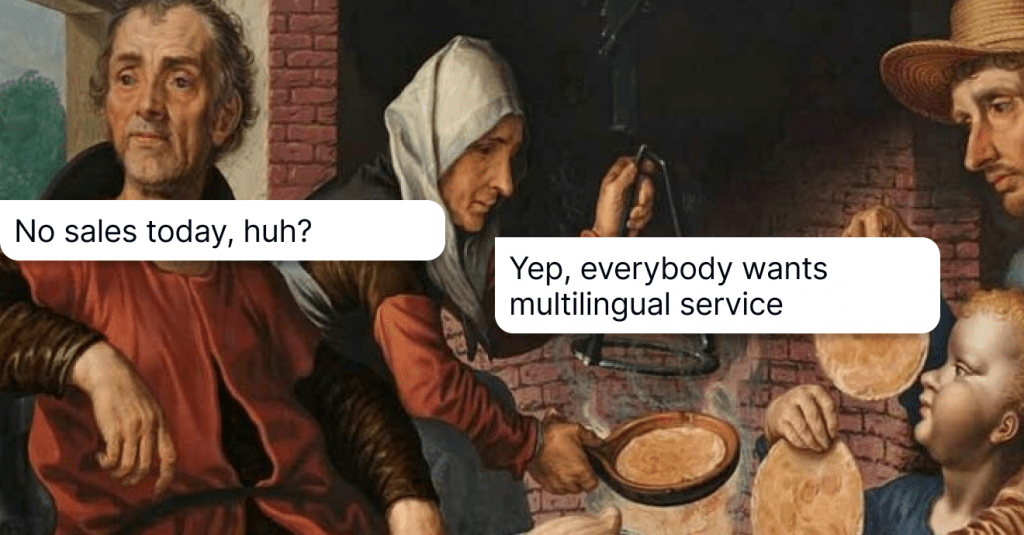How to Shape a Customer Service Philosophy That Motivates
Empowering customer service philosophy is a great way to motivate a team. Read on and take these 7 steps to implement one in your business.
Written by Anastasiia Khlystova

Customer service is often thought of as a dead-pan job to do. Some might even feel like it has nothing in common with real corporate culture and mutual endeavors. Well, it’s pretty much a cliché.
When you reach out to a support team, does it occur to you that those people on the other end struggle to go the extra mile for their clients day by day? For customer service representatives, the main focus is to do everything in their power to create a smooth experience for clients.
For the business, though, empowering the staff to deal with all sorts of customers should be the number one priority. A professional customer service center is one of the core factors of business success, this is why investing time and resources into the creation of a stellar customer support team should be on your to-do list.
Do you see where I am leading? You cannot provide uniformly excellent customer service without laying some ground rules. To achieve better customer retention and engagement, more happy customers, enhanced brand awareness, and overall growth, you need a strong customer service philosophy.
What is a customer service philosophy?
Among different definitions of philosophy, Merriam-Webster dictionary offers this one, too: the most basic beliefs, concepts, and attitudes of an individual or group. This definition is very much applicable to our current topic of customer philosophy.
A philosophy summarizes the company’s vision of exceptional customer service and outlines a list of values in handling customer issues and providing support. Most importantly, the philosophy lays the foundation for an actionable customer service strategy you develop together as a unit and practice on a day-to-day basis.
By the way, your company values mean nothing if the team doesn’t believe and implement them. No matter if you scream from the rooftops about your super open and customer service-oriented company but, in fact, fail to provide exceptional customer experience. Actions speak louder than words.
A holistic customer service vision isn’t something you can shape overnight and add as icing on the cake. In fact, it’s a way of thinking that comes from your organization’s core and reflects your company mission. To succeed in this endeavor, you should reason out your every step. This is what we’re going to elaborate on next.
7 steps to create an uplifting customer service philosophy
What is the basis of successful teamwork? Trust. If you want your staff to feel empowered, give them credit. As tempting as it may be to control everything that’s going on in your company, this is a dead-end road. You’d better take the following steps to shape a good customer support philosophy.
Step 1. Explore your buyer personas
Who are those people in your customer base? What are their preferences? And most importantly, what are their needs? If you managed to answer these questions, congratulations! You know everything about your buyer personas.
After you explore the information, see if you can cater to your customers’ needs according to three aspects:
- Preferred channel: if clients expect multichannel customer service, your platform should have a broad spectrum of options. For instance, HelpCrunch comprises everything from live chat and email to help desk to a self-service knowledge base. Isn’t it what any customer would wish for?
- Expectations: given that clients are now more demanding than ever, they expect such things as instant answers, personalized experiences, or contactless options. Make sure you provide all these things to meet customer expectations to the best extent possible.
- Customer service preferences: these could vary from industry to industry. For instance, if you work in the B2C sector, customer interactions may have a rather informal nature. However, if you’re engaged in B2B communications, build your dialogues more seriously (add a pinch of humor, though, it won’t go amiss?)
Step 2. Provide your team with the right tools
Your customer service reps won’t feel empowered unless they have all the right tools to act fast and vigorously. The ultimate customer service goals are to provide superior service and do it quickly. For that purpose, customer service reps should be able to escalate any issue to responsible departments as fast as possible, get back to clients via any channel they prefer, and resolve issues on the fly.
Let me use HelpCrunch, an all-in-one customer communication tool, as an example here. From the user’s perspective, it’s just a live chat window integrated with a website. They can leave their messages and communicate with the customer support team in real-time.
From the customer service reps’ perspective, though, HelpCrunch can be truly inspiring in terms of functionality and user experience:
- Robust messenger. Using straightforward tools instead of old-school overloaded software is truly empowering. Would you rather use WhatsApp or any other chat room from the 2000s to communicate with your friends? That’s what I’m talking about. A comfortable live chat tool is half the battle.
- Real-time customer data. HelpCrunch collects and tracks all necessary custom data and shows it in an agent chat. Your customer service reps can see what language a client speaks, where they are from, what pages they’ve just visited, what subscriptions they have, etc. This eliminates tons of redundant questions and helps your team resolve issues in the nick of time.
- Private notes. Leave private chat notes right in a chat window. If there’s a need to pass an issue to other teammates or departments, all your notes together with the full chat history will stay untouched.
- Customer satisfaction tracking. The most empowering thing in the world is feeling that your work and efforts are truly appreciated and create really amazing customer experiences. HelpCrunch helps the service team track customer satisfaction metrics and see how end-users feel about their experience with your company.
- Integrated knowledge base. Service agents can send articles to answer customer questions right from the chat. Besides, clients can easily find what they are looking for without waiting for a customer support rep to reply: the knowledge base is integrated into the chat widget.
- Shared inbox. HelpCrunch dashboard is not overloaded with redundant stuff. It’s straightforward and easy to start using it right away. Plus, there is no need to switch between some other workspace: everything happens under one unified helpdesk. So, your customer service team can sigh with relief.

Step 3. Be proactive
Let’s picture a battle. In the red corner, there is a brand with a customer service philosophy that is based on cooling the heels, waiting for a client to come first, and just minding its own business.
In the blue corner, we have a team of dedicated support pros who show their initiative, know when to reach out to a person, and what piece of advice to give. Fight!
Who is the winner? The team from the blue corner! They have a proactive approach and take advantage of it. One of the surefire ways to implement it in your workflow is setting up special messages and sending them via live chat.
For instance, you know that you get most of the traffic from your website’s pricing page. Any time a visitor navigates it, a proactive message will pop up saying you are always here should they have any questions. As a result, you may engage more leads, upsell to existing clients, and even gather valuable customer feedback.

4 aspirational customer service philosophy examples
1. Amazon’s customer centricity
Amazon’s customer support philosophy is that Jeff Bezos requires every single manager to be trained in the company’s call centers before anything else. He thinks it’s the most effective way to understand the needs of real customers.
The e-commerce behemoth also adopts a rather customer-centric approach in matters of refunds, replacements, and guarantees. The company offers refunds for missing or damaged items and even has a special guarantee covering your purchases from third parties.
This A-to-A Guarantee ensures that Amazon will handle your claim even when you did your business with another seller. Moreover, I don’t think that Amazon’s reps consult with the CEO on each of these cases – they’re empowered to meet their customers halfway and help them with anything they need.
2. Apple’s encrypted philosophy
“Get closer than ever to your customers. So close, in fact, that you tell them what they need well before they realize it themselves.” Steve Jobs
How could I NOT mention Apple’s philosophy of service? The thing is that it’s a golden standard of how you should get personal with your clients. It’s all in their acronym – A.P.P.L.E:
A – Approach customers with a personalized, warm welcome
P – Probe politely to understand all the customer’s needs
P – Present a solution for the customer to take home today
L – Listen for and resolve any issues or concerns
E – End with a fond farewell and an invitation to return
Interesting, isn’t it? I just came up with an idea to encrypt HelpCrunch’s customer service philosophy in our company’s title. So, what we have here is (try to do the same for your brand):
H – Help customers achieve their sought-after goals
E – Engage with every customer in an upbeat and prominent manner
L – Let customers know we care about them day by day
P – Provide timely and professional support
C – Create smooth experiences during the whole client lifecycle
R – Ruin stereotypes about lame customer service
U – Unite every team member for the client’s sake and success
N – Nail customer self-service with a profound knowledge base
C – Communicate an agile approach
H – Hold modern technologies together and improve them regularly
3. Buffer’s happiness team
Buffer is quite famous for the whole customer support system they’ve developed at their company. First of all, they call themselves a Happiness team, which is divided into three departments: happiness heroes, weekend warriors, and community champions.
Community champions are Buffer’s most autonomous members. Their main objective is to find proactive ways to build customer relationships. How cool is that? The company has this whole department looking for new ways to pleasantly surprise people who contact their customer support. That is what I call a customer-centric philosophy.
4. Virgin’s staff focus
Virgin Group is a British multinational venture capital company that offers products and services in many industries. Sir Richard Branson, its founder, places a premium on the company’s staff. That is, Virgin aims at delivering flawless experiences to both its employees and clients.
They describe their customer service philosophy with certain core values:

According to Richard Branson, Virgin Group founder and CEO, customer service is the core of their success. At the same time, he places the company employees higher than customers believing that only in this case both the business and the customers can achieve ultimate satisfaction:
…if you can put staff first, your customer second, and shareholders third, effectively, in the end, the shareholders do well, the customers do better, and yourself are happy.
Bottom line
Say what you will, I got inspired by this customer service philosophy guide. Here is what I think: the main recipe is staying consistent at all times. Your core ideas and customer service values should be clearly rendered and implemented from top to bottom.
The employees should know exactly what they’re doing and why. Only with a sense of significance, they can feel truly empowered. If you care to build great employee experiences, they are sure to translate into many more happy customers.
To help your team shoot for the stars and provide the greatest support, arm them with the software that will rock their workflow. Don’t take my word for it: create a free account with HelpCrunch to see what I mean.




